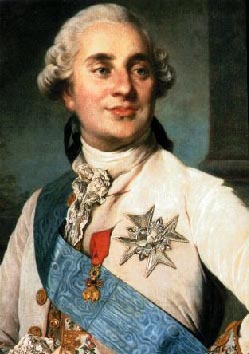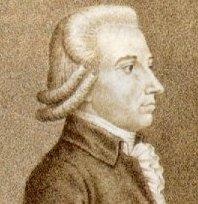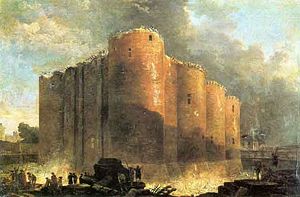French Revolution Timeline
From ThePlaz.com
The French Revolution Timeline - Western Civ Project
A Microsoft Word version of this work is available here: Image:French Revolution Descriptions After Grade.doc
Excel File Showing Actual Timeline
Contents |
May 10, 1774 - Louis XVI made King
King Louis the 16th became king in 1774. He was a weak leader and had trouble making decisions. Also, his wife, Marie Antoinette was despised by the French people because she came from long-hated Austria. She also spent money like crazy while the price of bread rose above the means of the people.
King Louis also created a lot of debt by helping the Americans beat long-time French enemy, Britain. In 1786, the banks refused to lend the king any more money causing the government to have serious troubles. Louis then called a meeting of the Estates-General to try and solve the money problem. Unfortunately this bad decision, along with the others he made, set the road to the French Revolution.
June 20, 1789 - Tennis Court Oath
When the Estates-General met, the third estate, in which 98% percent of the French citizens lived, demanded equal representation and taxation. Abbé Sieyès lead the revolt saying, “What is the Third Estate? Everything. What has it been in political order? Nothing. What does it demand? To be something herein.” Abbé led the delegates to have more influence and to be called the National Assembly. Three days later, they were locked out of their meeting room and met on a handball court to pronounce their Tennis Court Oath saying that they would end the absolute monarchy in France and write a new constitution.
This was the first deliberate act of revolution against the king. The Third Estate stood up against the Old Regime and declared an end to the absolute power of the monarchy. They were spreading the Enlightenment ideals that people can govern themselves and reforms are enacted in the name of the people. They were proactive in seeking a change of government.
July 14, 1789 - Storming of the Bastille
Louis XVI faced the new Assembly and did not know what to do, as usual. Because he no longer trusted the French soldiers to be loyal, he hired Swiss mercenaries to guard Paris. The citizens were scared of the Swiss soldiers and attacked the Bastille, where the gunpowder for the city was stored. The prison was defeated, but the mercenaries never came.
The fall of the Bastille, also the political prison, was a shot against the king. It has become the greatest symbolic act of the French Revolution. Today, July 14 is a national holiday in France. The fall of the Bastille also inspired women to walk ten miles to the king’s palace, Versailles. The women took the king from his magnificent palace to Paris, where he would stay forever. Also, peasants all over the countryside tore up old feudal papers and attacked nobles. This wave of revolution was called the Great Fear, as the peasants thought the nobles would send troops to attack them and the peasants were starting to fill their heads with revolutionary fever.
August 27, 1789 - Dec. of Rights of Man
A Declaration of the Rights of Man and the Citizen was passed by the National Assembly. All day in the National Assembly, nobles pronounced their support of liberty, equality, and fraternity (the slogan of the revolution). The nobles were forced to give up their special privileges from the Old Regime. This statement of revolutionary ideals gave all people the promise of the protection of their natural rights. It also granted all men the right to equal justice, freedom of speech, and freedom of religion.
This document granted essential natural rights to all men. It was made up of mostly Enlightenment ideas. This set the tone of the revolution. This was the starting point on the road, with even more reforms building up later on.
October 1, 1791 - Legislative Assembly Created
The Natio





